AUDI A4 CABRIOLET 2009 Owners Manual
Manufacturer: AUDI, Model Year: 2009, Model line: A4 CABRIOLET, Model: AUDI A4 CABRIOLET 2009Pages: 340, PDF Size: 77.32 MB
Page 161 of 340
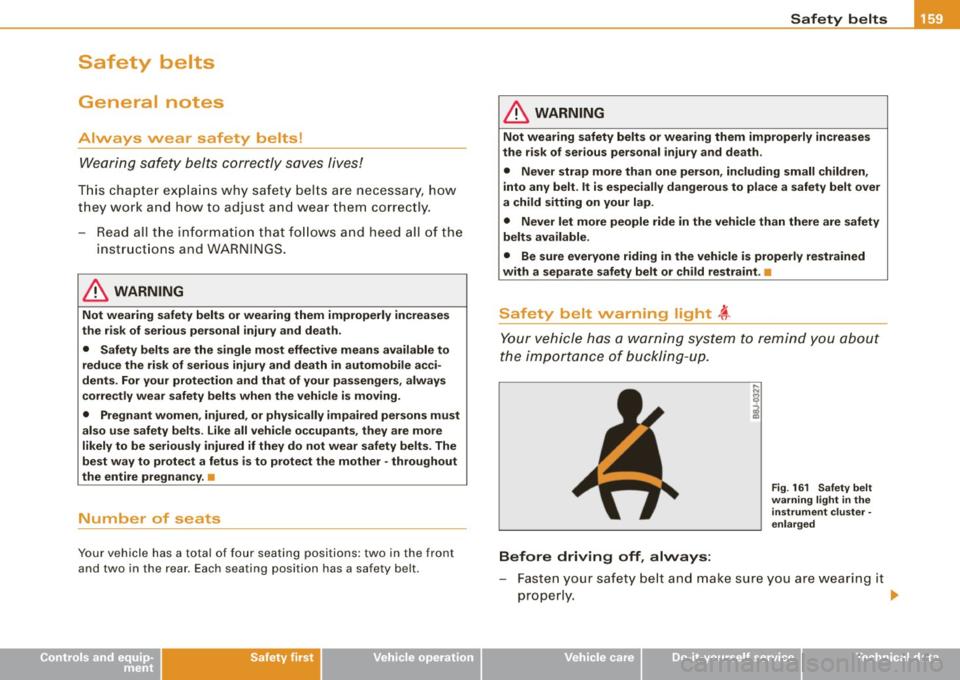
_______________________________________________ S_a _f _e _t -=-y _ b_ e_lt _s ______ lffllll
Safety belts
General notes
Always wear safety belts!
Wearing safety belts correctly saves lives!
This chapter explains why safety belts are necessary, how
they work and how to adjust and wear them correctly.
- Read all the information that follows and heed all of the
instructions and WARNINGS.
& WARNING
Not wearing safety belts or wearing them improperly increases
the risk of serious personal injury and death.
• Safety belts are the single most effective means available to
reduce the risk of serious injury and death in automobile acci
dents. For your protection and that of your passengers, always
correctly wear safety belts when the vehicle is moving.
• Pregnant women, injured, or physically impaired persons must
also use safety belts . Like all vehicle occupants, they are more
likely to be seriously injured if they do not wear safety belts. The
best way to protect a fetus is to protect the mother -throughout
the entire pregnancy. •
Number of seats
Your vehicle has a total of four seating positions : two in the front
and two in the rear. Each seating posi tion has a safety belt .
Controls and equip ment Safety first
Vehicle operation
& WARNING
Not wearing safety belts or wearing them improperly increases
the risk of serious personal injury and death.
• Never strap more than one person, including small children,
into any belt. It is especially dangerous to place a safety belt over
a child sitting on your lap.
• Never let more people ride in the vehicle than there are safety
belts available.
• Be sure everyone riding in the vehicle is properly restrained
with a separate safety belt or child restraint. •
Safety belt warning light ~
Your vehicle has a warning system to remind you about
the importance of buckling-up.
Before driving off, always:
Fig. 161 Safety belt
warning light in the
instrument cluster ·
enlarged
- Fasten your safety belt and make sure you are wearing it
properly. .,
Vehicle care Do-it-yourself service Technical data
Page 162 of 340
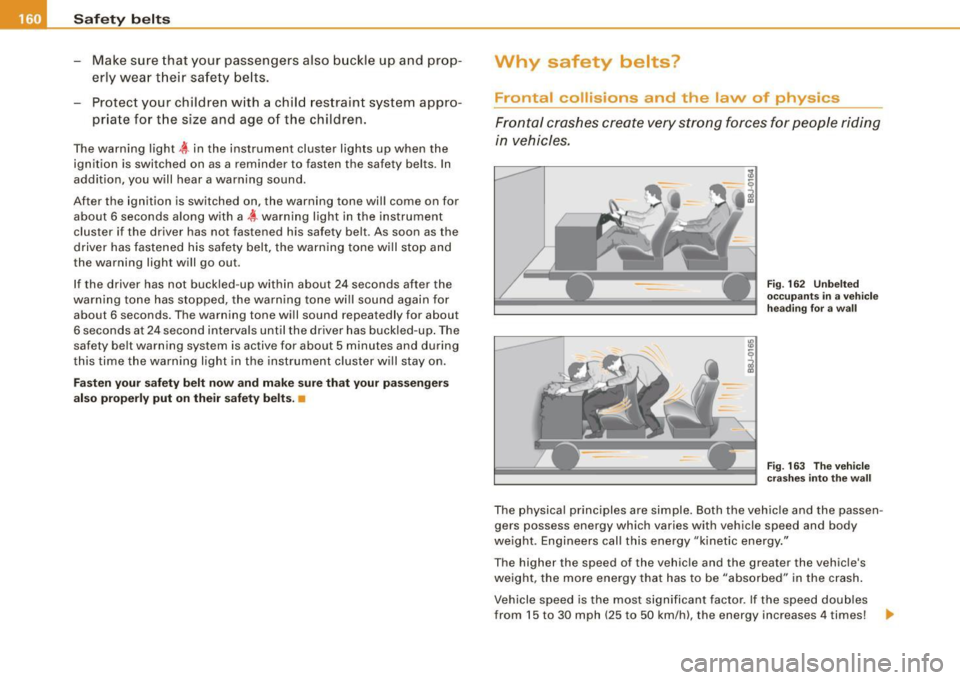
___ S_a_ f_ e_ t-= y_ b_e_ l_ t _s _______________________________________________ _
- Make sure that your passengers also buckle up and prop
er ly wea r th eir sa fe ty be lts.
Protect your children with a child restraint system appro
pria te for t he size and age o f the children.
The warning light~ in the instrument cluster lights up when the
ignition is switched on as a reminder to fasten the safety belts. In
addition, you will hear a warning sound.
After the ignition is switched on, the warning tone will come on for about 6 seconds a long w ith a-~ warning light in the instru ment
cluster if the driver has not fastened his safety belt . As soon as the
driver has fastened his safety belt, the warning tone will stop and
the warning light will go out .
I f the driver has not buckled -up within about 24 seconds after the
warn ing tone has stopped, the warn ing tone will sound again for
about 6 seconds. The warning tone will sound repeated ly for about
6 seconds at 24 second intervals unti l the driver has buckled-up . The
safety belt warning system is active for about 5 minutes and during
this time the wa rning light in the instrument c luster will stay on.
Fa sten you r safety belt no w and make sure that your pa ssengers
also properl y put on the ir saf ety belts. •
Why safety belts?
Frontal collisions and the law of physics
Frontal crashes create ve ry strong forces for pe ople ri ding
in vehicles.
Fig . 16 2 Unbel ted
occ upants in a ve hicle
h ead in g fo r a wall
F ig . 16 3 T he vehi cle
c ras he s in to t he wa ll
The physica l principles are simple. Both the vehicle and the passen
gers possess energy which varies with vehicle speed and body
we ight . Engineers call this energy "kinetic energy ."
The higher the speed of the vehicle and the greater the vehicle's
we ight, the mo re energy that has to be "absorbed" in the crash .
Vehicle speed is the most significant factor. If the speed doub les
from 15 to 30 mph (25 to 50 km/h), the energy increases 4 times!
~
Page 163 of 340

Because the passengers of this vehicle are not using safety belts
~ page 160, fig. 162, they will keep moving at the same speed the
vehicle was moving just before the crash, until something stops
them -here, the wall
~ page 160, fig. 163.
The same principles apply to people sitting in a vehicle that is involved in a frontal collision. Even at city speeds of 20 to 30 mph
(30 to 50 km/h), the forces acting on the body can reach one ton
(2,000 lbs, or 1,000 kg) or more. At greater speeds, these forces are
even higher.
People who do not use safety belts are also not attached to their
vehicle. In a frontal collision they will also keep moving forward at
the speed their vehicle was travelling just before the crash. Of course, the laws of physics don't just apply to frontal collisions, they
determine what happens in all kinds of accidents and collisions. •
What happens to occupants not wearing
safety belts?
In crashes unbelted occupants cannot stop themselves
from flying forward and being injured or killed. Always
wear your safety belts!
Safety first
Fig . 164 A driver not
wearing a safety belt is
violently thrown
forward
Safety belts
Fig. 165 A rear
passenger not wearing
a safety belt will fly
forward and strike the
driver
Unbelted occupants are not able to resist the tremendous forces of
impact by holding tight or bracing themselves. Without the benefit
of safety restraint systems, the unrestrained occupant will slam
violently into the steering wheel, instrument panel, windshield, or
whatever else is in the way~ fig. 164 . This impact with the vehicle
interior has all the energy they had just before the crash.
Never rely on airbags alone for protection. Even when they deploy,
airbags provide only additional protection. Airbags are not
supposed to deploy in all kinds of accidents. Although your Audi is
equipped with airbags, all vehicle occupants, including the driver,
must wear safety belts correctly in order to minimize the risk of
severe injury or death in a crash.
Remember too, that airbags will deploy only once and that your
safety belts are always there to offer protection in those accidents
in which airbags are not supposed to deploy or when they have
already deployed. Unbelted occupants can also be thrown out of the
vehicle where even more severe or fatal injuries can occur.
It is also important for the rear passengers to wear safety belts
correctly . Unbelted passengers in the rear seats endanger not only
themselves but also the driver and other passengers~ fig. 165. In a
frontal collision they will be thrown forward violently, where they can hit and injure the driver and/or front seat passenger. •
~ehicle care Technical data
Page 164 of 340
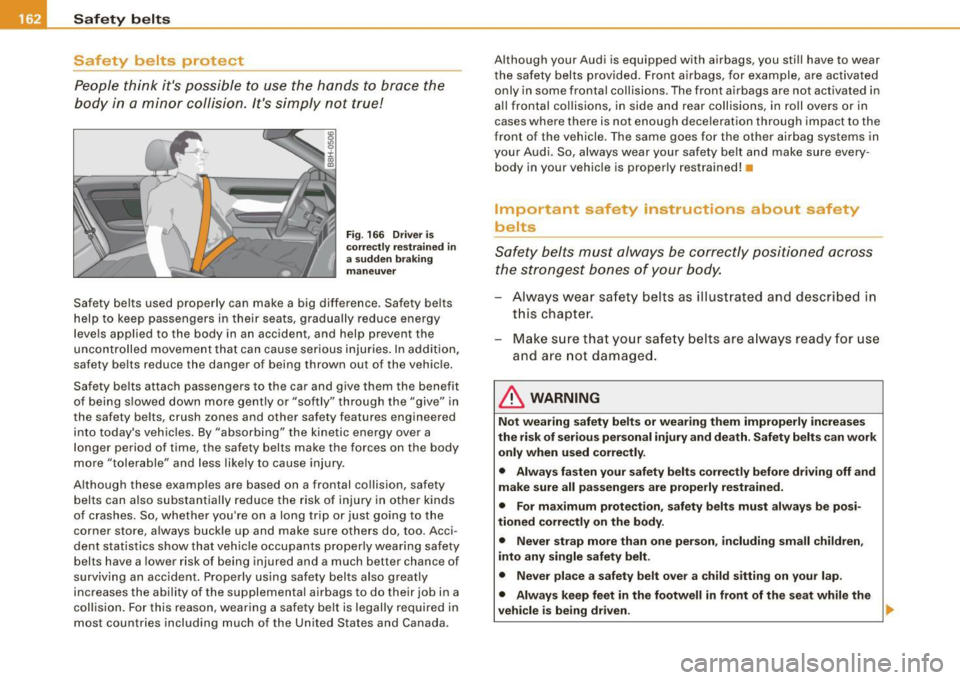
--~S~a ~f ~e ~t l'.y ...: b~ e~lt =:s!._ _____________________________________________ _
Safety belts protect
People think it's possible to use the hands to brace the
body in a minor collision . It's simply not true!
Fig . 166 Dri ver is
co rrec tly r est rai ned i n
a s ud den braking
man euv er
Safety belts used properly can make a big difference . Safety belts
help to keep passengers in their seats, gradually reduce energy levels app lied to the body in an accident, and help prevent the
uncontrolled movement that can cause serious injuries . In addition,
safety be lts reduce the danger of being thrown out of the vehic le.
Safety belts attach passengers to the car and give them the benefit
of being s lowed down more gently or "sof tly" through the "give" in
the safety belts, crush zones and other safety features engineered
into today's vehicles. By "absorbing" the kinetic energy
over a
longer period of time, the safety belts make the forces on the body
more "tolerable" and less likely to cause injury.
Although these examples are based on a frontal co llision, safety
belts can a lso substantially reduce the risk of injury in other kinds
of crashes. So, whether you're on a long tr ip or just going to t he
corner store, always buckle up and make sure others do, too. Acci
dent statistics show that vehic le occupants properly wearing safety
belts have a lower risk of being injured and a much better chance of
s u rviv ing an acc ident. Proper ly using safety belts also great ly
increases the abi lity of the supplementa l airbags to do their job in a
coll ision. For this reason, wearing a safety be lt is legally required in
most countries including much of the United States and Canada . Although your Audi is equipped with airbags, you sti
ll have to wear
t he safety belts provid ed. Fron t airbags, for example, are activated
only in some frontal collisions. The front airbags are not activated in
a ll frontal co llisions, in side and rear collisions, in ro ll
ove rs or in
cases where there is not enough dece leration through impact to the
front of the vehicle. The same goes for the other ai rbag systems in
your Audi. So, a lways wear your safety belt and make sure
eve ry
body in your vehic le is properly restrained! •
Important safety Instructions about safety
belts
Safety belts must always be correctly positioned across
the strongest bones of your body.
Always wear safety belts as illustrated and described in
this cha pte r.
Make s ure tha t your sa fe ty belts ar e always ready for us e
and are not damaged .
& WARNING
Not wearing safety belts or wearing them improperl y increases
the risk of serious per sonal injury and death . Safety belt s can w ork
only when used corre ctl y.
• Alway s fa sten yo ur safety belt s correctl y before driving off and
make sure all pa ssenger s are properl y restrained .
• For m aximum protection , safet y belts must alw ays be po si
tion ed corre ctly on the body .
• Never strap mo re than one person , including sm all children ,
into any single safety belt.
• Never pla ce a s afety belt ove r a child sitting on your lap .
• Alway s ke ep feet in the footwell in front of the seat while the
vehicle is being dr iven .
~
Page 165 of 340
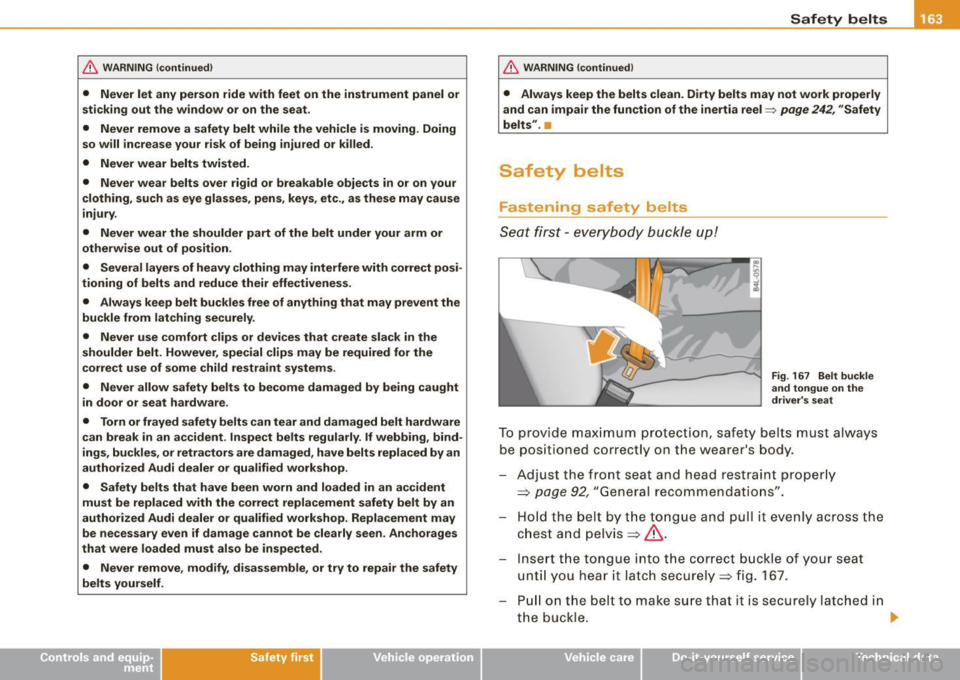
& WARNING (continued)
• Never let any person ride with feet on the instrument panel or
sticking out the window or on the seat.
• Never remove a safety belt while the vehicle is moving. Doing
so will increase your risk of being injured or killed.
• Never wear belts twisted .
• Never wear belts over rigid or breakable objects in or on your
clothing, such as eye glasses, pens, keys , etc. , as these may cause
injury .
• Never wear the shoulder part of the belt under your arm or
otherwise out of position .
• Several layers of heavy clothing may interfere with correct posi
tioning of belts and reduce their effectiveness.
• Always keep belt buckles free of anything that may prevent the
buckle from latching securely.
• Never use comfort clips or devices that create slack in the
shoulder belt. However , special clips may be required for the
correct use of some child restraint systems.
• Never allow safety belts to become damaged by being caught
in door or seat hardware .
• Torn or frayed safety belts can tear and damaged belt hardware
can break in an accident . Inspect belts regularly. If webbing, bind
ings, buckles , or retractors are damaged , have belts replaced by an
authorized Audi dealer or qualified workshop.
• Safety belts that have been worn and loaded in an accident
must be replaced with the correct replacement safety belt by an
authorized Audi dealer or qualified workshop. Replacement may
be necessary even if damage cannot be clearly seen. Anchorages
that were loaded must also be inspected.
• Never remove, modify, disassemble, or try to repair the safety
belts yourself .
Safety first
Safety belts
& WARNING (continued)
• Always keep the belts clean. Dirty belts may not work properly
and can impair the function of the inertia reel
~ page 242, "Safety
belts" .•
Safety belts
Fastening safety belts
Seat first -everybody buckle up!
Fig. 167 Belt buckle
and tongue on the
driver 's seat
To provide maximum protection, safety belts must always
be positioned correctly on the wearer's body .
Adjust the front seat and head restraint properly
=> page 92, "General recommendations".
Hold the belt by the tongue and pull it evenly across the
chest and pelvis=>& .
Inse rt the tongue into the correct buckle of your seat
until you hear it latch securely=> fig. 167.
Pull on the belt to make sure that it is securely latched in
the buckle. ..,
~ehicle care irechnical data
Page 166 of 340
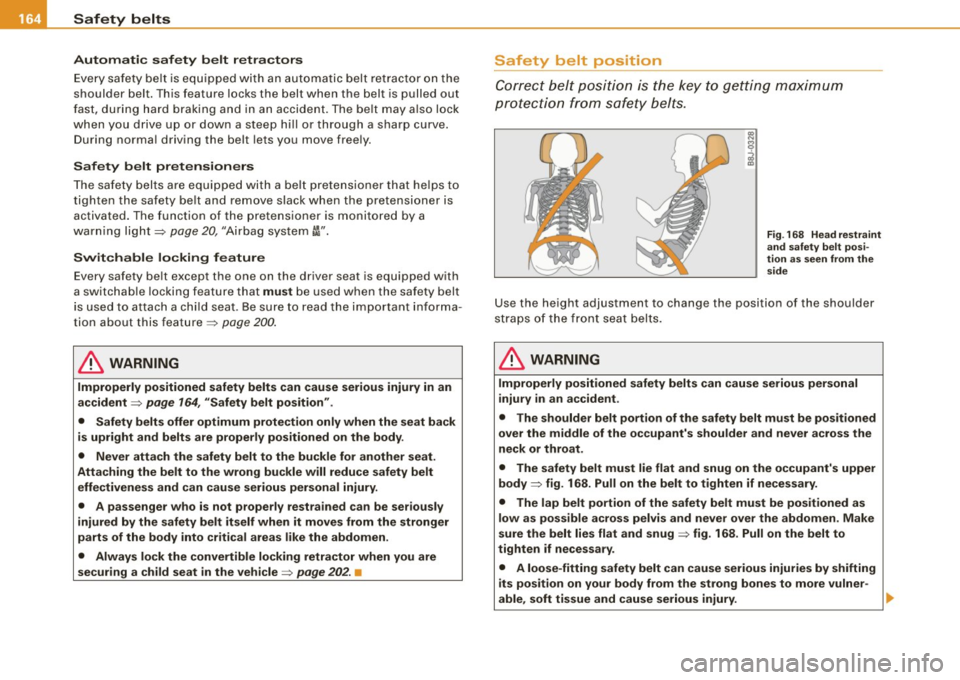
-Safety belts ___ .:,__ _____________________________________ _
Automatic safety belt retractors
Every safety belt is equipped with an automatic belt retractor on the
shoulder bel t. This featu re locks the bel t when the belt is pulled out
fast, during hard braking and in an accident. The belt may also lock
when you drive up or down a steep hill or through a sharp curve. During normal driving the bel t lets you move freely.
Safety belt pretensioners
The safety belts are equipped with a belt pretension er that helps to
tighten the safety belt and remove slack when the pretensioner is
activated. The function of the pretensioner is monitored by a
warning light:::::, page
20, "Airbag system @;".
Switchable locking feature
Every safe ty belt except the one on the driver seat is equipped with
a switchable locking feature that must be used when the safety belt
is used to attach a child seat . Be sure to read the important informa
tion about this feature:::::, page
200.
& WARNING
Improperly positioned safety belts can cause serious injury in an
accident :::::,
page 164, "Safety belt position" .
• Safety belts offer optimum protection only when the seat back
is upright and belts are properly positioned on the body.
• Never attach the safety belt to the buckle for another seat.
Attaching the belt to the wrong buckle will reduce safety belt
effectiveness and can cause serious personal injury.
• A passenger who is not properly restrained can be seriously
injured by the safety belt itself when it moves from the stronger
parts of the body into critical areas like the abdomen.
• Always lock the convertible locking retractor when you are
securing a child seat in the vehicle :::::,
page 202. •
Safety belt position
Correct belt position is the key to getting maximum
protection from safety belts.
Fig . 168 Head restraint
and safety belt posi
tion as seen from the
side
Use the height adjustmen t to change the position of the shoulder
straps of the front seat belts.
in. WARNING
Improperly positioned safety belts can cause serious personal
injury in an accident .
• The shoulder belt portion of the safety belt must be positioned
over the middle of the occupant's shoulder and never across the
neck or throat.
• The safety belt must lie flat and snug on the occupant's upper
body
:::::> fig. 168. Pull on the belt to tighten if necessary.
• The lap belt portion of the safety belt must be positioned as
low as possible across pelvis and never over the abdomen. Make
sure the belt lies flat and snug :::::, fig. 168. Pull on the belt to
tighten if necessary.
• A loose-fitting safety belt can cause serious injuries by shifting
its position on your body from the strong bones to more vulner-
able, soft tissue and cause serious injury. ..,.
Page 167 of 340
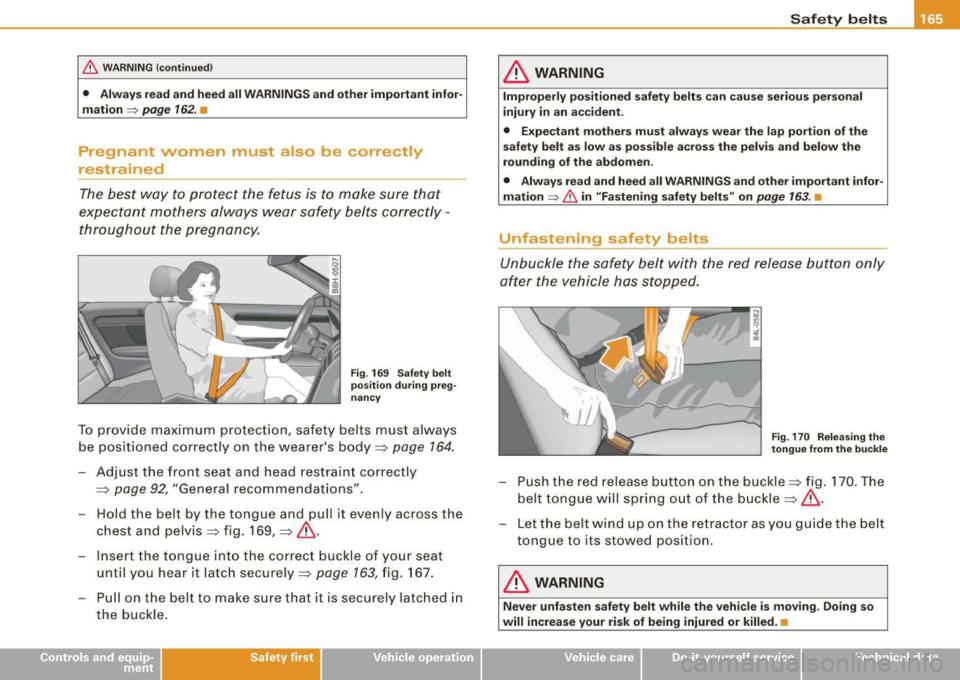
& WARNING (continued)
• Always read and heed all WARNINGS and other important infor
mation
=> page 162. •
Pregnant women must also be correct ly
restrained
The best way to protect the fetus is to make sure that
expectant mothers always wear safety belts correctly·
throughout the pregnancy.
Fig . 169 Safety belt
position during preg
nancy
To provide maximum protection, safety belts must always
be posit ioned correctly on the wearer's body=>
page 164.
-Adjust the front seat and head restraint correctly
=>
page 92, "General recommendations".
- Hold the belt by the tongue and pull it evenly across the
chest and pelvis=> fig. 169, =>
&.
- Insert the tongue into the correct buckle of your seat
until you hear it latch securely=>
page 163, fig. 167.
- Pull on the belt to make sure that it is securely latched in
the buck le.
Safety first
Safety belts
& WARNING
Improperly positioned safety belts can cause serious personal
injury in an accident.
• Expectant mothers must always wear the lap portion of the
safety belt as low as possible across the pelvis and below the
rounding of the abdomen.
• Always read and heed all WARNINGS and other important infor
mation =>
& in "Fastening safety belts" on page 163. •
Unfastening safety belts
Unbuckle the safety belt with the red release button only
after the vehicle has stopped.
Fig . 170 Releasing the
tongue from the buckle
- Push the red release button on the buckle=> fig. 170. The
belt tongue will spring out of the buckle =>
&.
- Let the belt wind up on the retractor as you guide the belt
tongue to its stowed position.
& WARNING
Never unfasten safety belt while the vehicle is moving. Doing so
will increase your risk of being injured or killed. •
~ehicle care irechnical data
Page 168 of 340
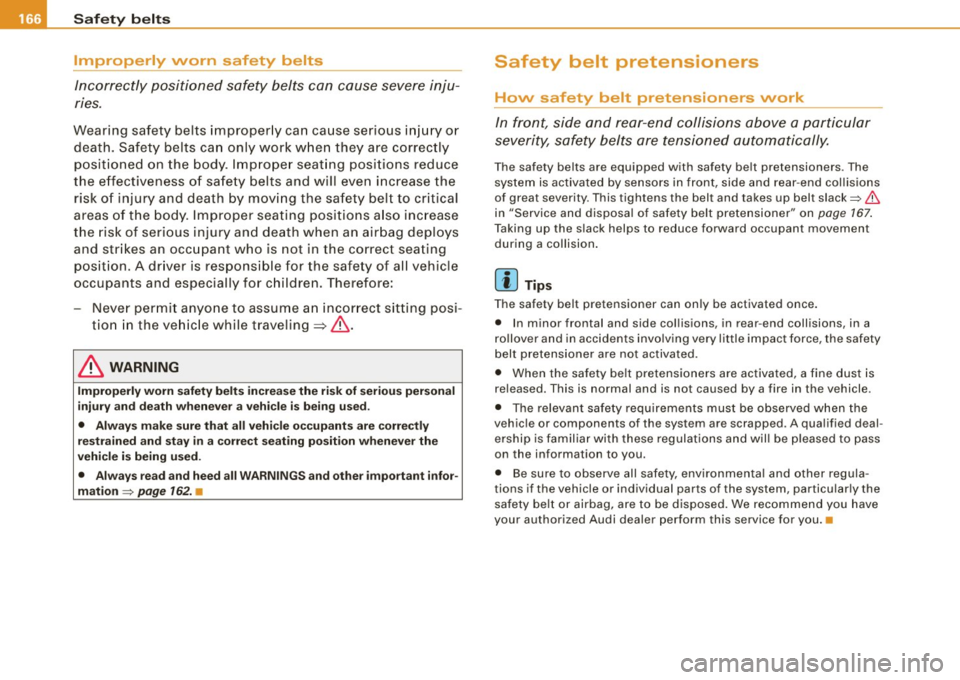
___ S_a_ f_ e_ t..: y_ b_e_ l_ t _s _______________________________________________ _
Improperly worn safety belts
Incorrectly positioned safety belts can cause severe inju
nes.
Wearing safety belts improperly can cause serious injury or
death. Safety belts can only work when they are correctly positioned on the body. Improper seating positions reduce
the effectiveness of safety belts and will even increase the
risk of injury and death by moving the safety belt to critical
areas of the body. Improper seating positions also increase
the risk of serious injury and death when an airbag deploys
and strikes an occupant who is not in the correct seating
position . A driver is responsible for the safety of all vehicle
occupants and especially for children. Therefore:
- Never permit anyone to assume an incorrect sitting posi
tion in the vehicle while traveling=>&.
& WARNING
Improperly worn safety belts increase the risk of serious personal
injury and death whenever a vehicle is being used.
• Always make sure that all vehicle occupants are correctly
restrained and stay in a correct seating position whenever the
vehicle is being used.
• Always read and heed all WARNINGS and other important infor
mation
=> page 162. •
Safety belt pretensioners
How safety belt pretensioners work
In front, side and rear-end collisions above a particular
severity, safety belts are tensioned automatically.
The safety belts are equipped with safety belt pretensioners . The
system is activated by sensors in front, side and rear -end collisions
of great severity . This tightens the belt and takes up belt slack=>&.
in "Service and disposal of safety belt pretensioner" on
page 167.
Taking up the slack helps to reduce forward occupant movemen t
during a collision.
[ i] Tips
The safety belt pretensioner can only be activated once.
• In minor frontal and side collisions , in rear-end collisions, in a
rollover and in accidents involving very little impact force, the safety
belt pretension er are not activated.
• When the safety belt pretensioners are activated, a fine dust is
released. This is normal and is not caused by a fire in the vehicle.
• The relevant safety requirements must be observed when the
vehicle or components of the system are scrapped . A qualified deal
ership is familiar with these regulations and will be pleased to pass
on the information to you.
• Be sure to observe all safety, environmental and other regula
tions if the vehicle or individual parts of the system, particularly the
safety belt or airbag, are to be disposed. We recommend you have
your authorized Audi dealer perform this service for you. •
Page 169 of 340

_______________________________________________ S_a _f _e _t -=-y _ b_ e_lt _s ______ lll
Service and disposal of safety belt
pretension er
The safety belt pretensioners are parts of the safety belts on your
Aud i. Installing, re mov ing, servicing or repairing of belt preten
sioners can damage the safety belt system and prevent it from
wo rk ing correct ly in a coll ision.
There are some important things you have to know to make sure
t ha t th e effectiveness of the system w ill not be impai red and that
discarded components do not cause injury or pollute the environ
ment .
& WARNING
Improper care , servicing and repair procedure s can increase the
risk of personal injury and death by preventing a safety belt
preten sioner from activating when needed or activating it unex
pe ctedly :
• The belt preten sioner system can be activated only once. If belt
preten sioner s have been act ivated , the sy stem mu st be repla ced.
• Never repair , adju st, or change any part s of the safety belt
system .
• Safety belt sy stem s including safety belt pretensioners cannot
be repaired . Spe cial pro cedure s are required for removal, installa
tion and di spo sal of thi s s ystem .
• For any work on the safety belt s ystem , we strongl y re com
mend that you see your authorized Audi dealer or qual ified techni
ci an who ha s an Aud i approved repair m anu al, tr aining and spe cial
equipment nece ssary .
W For the sake of the environment
Undeployed airbag modu les and pretensioners might be classified
as Perchlorate Material -special handling may apply, see
www .dtsc .ca .gov/hazardouswaste/perchl ora te. When the vehicle or
Controls and equip ment Safety first Vehicle operation parts of the restraint system including airbag modules safety be
lts
wi th pre te nsi oners are scrapped, a ll applicable laws and reg ula
tions must be observed . Your authorized Audi dealer is familiar with
these req uirements and we recommend tha t you have you r dealer
perform this service for you. •
Vehicle care Do-it-yourself service Technical data
Page 170 of 340
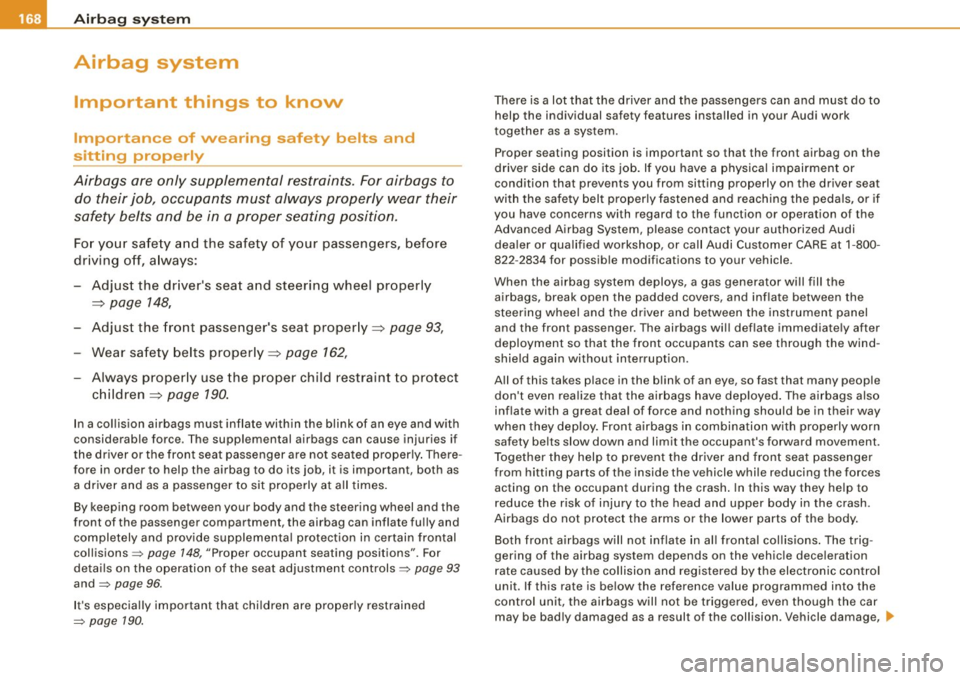
___ A_ ir_b _ a_ g~ s_ y_s _t _e _m _________________________________________________ _
Airbag system
Important things to know
Importance of wearing safety belts and
sitting properly
Airbags are only supplemental restraints. For airbags to
do their job, occupants must always properly wear their
safety belts and be in a proper seating position.
For your safety and the safety of your passengers, before
driving off, a lways:
- Adjust the driver's seat and steering wheel properly
=>
page 148,
- Adjust the front passenger's seat properly => page 93,
- Wear safety belts properly=> page 162,
- Always properly use the proper child restraint to protect
children=>
page 190 .
In a collision airbags must inflate within the blink of an eye and with
considerable force . Th e suppl emental airbags can caus e injuries if
the driver or the front seat passenger are not seated proper ly . There
fore in order to help the airbag to do its job, it is impor tant, both as
a driver and as a passenger to sit properly at all times.
By keeping room between your body and the steering wheel and the
front of the passenger compartment, the airbag can inflate fully and
completely and prov ide supplementa l protection in certain frontal
collisions ~
page 148, "Proper occupant seating positions" . For
details on the operation of the seat adjustment controls~
page 93
and ~ page 96.
It's especially important that chi ldren are proper ly restrained
~ page 190.
There is a lot that the driver and the passengers can and must do to
help the individual safety features installed in your Audi work
together as a system.
Proper seating posi tion is important so that the front airbag on the
driver side can do its job. If you have a physical impairment or
condition that prevents you from sitting properly on the driver seat
with the safety belt properly fastened and reaching the pedals, or if
you have concerns with regard to the function or operation of the
Advanced Airbag System, please contact your authorized Audi
dea ler or qua lif ied workshop, or call Audi Customer CARE at 1-800 -
822 -2834 for possible modifications to your vehicle .
When the airbag system deploys, a gas generator wi ll fill the
airbags, break open the padded covers, and inflate between the
steering wheel and the driver and between the instrument panel
and the front passenger. The airbags will deflate immediately after
deployment so that the front occupants can see through the wind
shield again without interruption .
All of this takes p lace in the blink of an eye, so fast that many people
don't even rea lize that the airbags have dep loyed. The airbags also
inflate with a great deal of force and nothing should be in their way
when they deploy . Front airbags in combination with properly worn
safety bel ts slow down and limit the occupant's forward movement.
Together they help to prevent the driver and front seat passenger
from hitting parts of the inside the vehicle while reducing the forces acting on the occupant during the crash . In this way they help to
reduce the risk of injury to the head and upper body in the crash .
Airbags do not protect the arms or the lower parts of the body.
Both front airbags w ill not in flate in al l frontal collisions . The trig
gering of the airbag system depends on the vehic le deceleration
rate caused by the collision and registered by the electronic contro l
unit. If this rate is below the reference value programmed into the
control unit, the airbags will not be triggered, even though the car
may be badly damaged as a result of the collision . Vehicle damage, .,